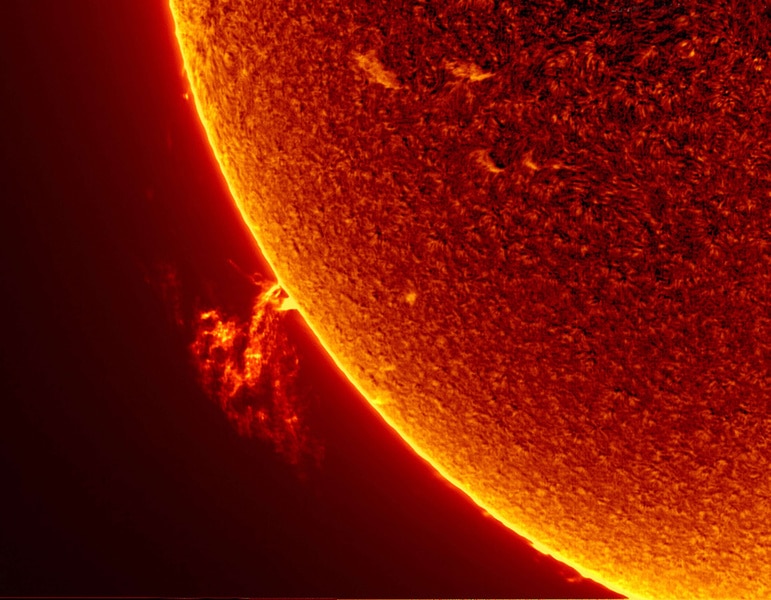Create a free profile to get unlimited access to exclusive videos, sweepstakes, and more!
Powerful Solar Storm Triggers Radio Blackouts Across Pacific Region
Sometimes our radios don't work when the Sun is screaming.
The Sun is responsible for providing light and warmth to our world; it feeds plants through photosynthesis and provides the foundation for the entire web of life on our planet. Every morning it rises over the horizon and sets again in the evening, painting the sky in brilliant hues. It’s the furnace that keeps us warm and provides an oasis in an otherwise cold universe. And like a furnace, sometimes it threatens to explode.
In the disaster flick Solar Attack, a powerful solar explosion interacts with methane in the atmosphere and lights the sky on fire. Fortunately for us, solar events aren’t quite that dramatic, but they can sow chaos on Earth when they’re strong enough. On April 30, a particularly powerful solar flare triggered temporary radio blackouts across the Pacific region. The flare erupted from sunspot region 2346 and flares like it are likely to become more common as we approach the peak of Solar Cycle 25.
For More on the Sun:
Parker Solar Probe Set to Break the Solar System Speed Record Again!
What Were Those Weird Red Spots During the 2024 Solar Eclipse?
Understanding the Sun's Solar Cycle and Coronal Mass Ejections (CMEs)
What Are Solar Flares and How Are They Categorized?
A solar flare is a burst of electromagnetic radiation erupting from the surface of the Sun. They typically last a few minutes or hours and they travel at the speed of light, such that as soon as we notice them they are already here. That differs from coronal mass ejections (CMEs), which are bursts of charged plasma, actual energized material sloughed off from the Sun’s face. They can take hours or days to reach us and they trigger auroras and geomagnetic storms.
Solar flares most often sprout up inside sunspot regions, areas characterized by strong magnetic fields. When those magnetic fields become unstable, they explode and unleash X-rays and extreme ultraviolet (EUV) radiation. When that radiation reaches the planet, it ionizes the lower layers of the ionosphere, churning up the air.
Each observed solar flare is classified based on the peak emission of X-rays. The lowest class is A, followed by B, C, M, and X. Similar to the Richter scale used for measuring earthquakes, each letter in the solar flare scale represents a tenfold increase in strength, making X-class flares 10,000 times more powerful than A-class flares. In an effort to get a little more granular, each letter class is also broken down on a 1 - 9 scale with the exception of X-class flares, which are limited only by how much of a hissy fit the Sun throws.
Generally speaking, a C-class flare or smaller is too weak to influence the planet in a noticeable way, but the April 30 flare clocked in at M9.5... and people felt it!
An M-Class Solar Flare Hit the Pacific on April 30, 2024
On April 30, before the solar flare kicked off, Space Weather reported a potential X-class flare being cooked up inside sunspot region AR3654. Initial measurements indicated it had enough energy to create an X-class flare, though they noted that smaller flares from the region could release some of that energy, leaving less leftover for the big one. That’s precisely what happened.
By the time the big flare kicked off, enough energy had been sapped that it just missed X-class status. Still, it was powerful enough to cause radio blackouts around the Pacific region. Radio signals regularly interact with the ionosphere as they travel between transmitters and receivers. Usually, when a radio wave gets near the ionosphere it benefits from refraction which steers it away from highly ionized areas, allowing it to travel longer distances unscathed.
However, when a strong enough solar flare churns up the ionosphere, radio waves can’t move around it as easily. Collisions with ionized particles create noise and energy loss, degrading the signal or absorbing it completely. When that happens, radio communications get lost in the noise and we experience a radio blackout. The blackout on April 30 lasted for about 30 minutes before the solar flare’s influence dissipated and things returned to normal.
With a little bit of luck, we’ll get through the looming Solar Maximum, when solar flares and coronal mass ejections are at their peak, without too much trouble. But solar activity like this is a stark reminder of the sheer power and proximity of our star.
Solar Attack is streaming now on Peacock.
































